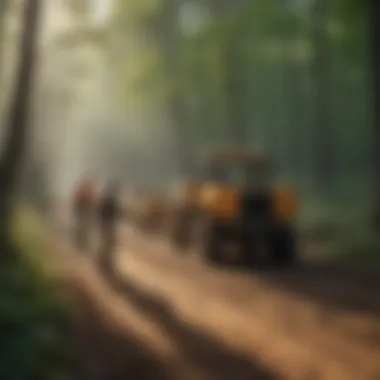Discovering Brown County Mountain Bike Trails Guide


Intro
Nestled in the heart of southern Indiana, Brown County is a hotbed for outdoor enthusiasts, especially those who have a penchant for mountain biking. The lush landscapes, steep hills, and winding trails attract riders of all skill levels. But as we venture through these scenic routes, it's essential to appreciate the ecosystem that supports this recreational paradise. This guide will not only dissect the captivating trails but will also underscore the ecological significance intertwined with mountain biking in Brown County.
As we delve deeper into the context surrounding these trails, we'll explore the synergy between responsible riding and woodland stewardship. Understanding the delicate ecosystems we traverse fosters a relationship with the land that is both enriching and respectful. Let's gear up and explore the nuances of Brown County's mountain biking experience, starting with the foundational aspect of our journey: the woodland ecosystems.
Foreword to Brown County Mountain Bike Trails
Brown County is a hidden gem for mountain biking enthusiasts, serving up a mix of scenic views, diverse terrain, and a rich community rooted in outdoor recreation. The trails here are not merely paths through the woods; they are a tapestry of experiences interwoven with nature’s beauty and the thrill of biking. In this section, we will delve into the vital aspects that make these trails worthy of exploration, focusing on their historical context and geographical overview.
Historical Context
The mountain biking scene in Brown County did not sprout overnight. Rather, it evolved from the local love for outdoor spaces and a push towards responsible recreation. Historically, the area was recognized for its natural beauty and biodiversity, attracting early conservationists. As the sport of mountain biking gained popularity in the late 20th century, local organizations began to take notice of the potential for trails that not only provided thrilling rides but also fostered community and conservation efforts.
For instance, the Brown County Mountain Bike Association formed in the mid-2000s, championing the cause of sustainable trail development. Their efforts are reflected in the continued improvement of existing trails and the introduction of new ones, ensuring that riders have adventures while supporting the ecological balance of the area. Comprehending this history helps one appreciate the trails' significance—not just as recreational options but as synergistic spaces where sport and stewardship go hand in hand.
Geographical Overview
Understanding the lay of the land is essential when embarking on a biking adventure. Brown County sits in southern Indiana, with its rolling hills and expansive forested areas forming a picturesque backdrop for mountain biking. The dramatic topography offers a variety of trail types, from gentle slopes suitable for beginners to challenging climbs that test even the most seasoned riders.
The trails in Brown County often wind through hardwood forests, with species like oak, maple, and hickory creating a rich canopy. This unique environment not only provides excellent biking conditions but also offers the chance to observe an array of wildlife. Riders might spot deer, foxes, or a diverse range of bird species as they navigate the trails. The interwoven aspect of trails within such environments enhances the biking experience, allowing riders to enjoy both physical activity and the wonders of nature.
As we dive deeper into this guide, keep in mind the historical roots and geographical richness of Brown County mountain bike trails. They pave the way for responsible enjoyment of the outdoors, laying the foundation for sustainable practices that benefit both bikers and the environment.
Trail Varieties in Brown County
The trail varieties in Brown County signify a rich tapestry of experiences tailor-made for mountain bikers of all capabilities. Understanding these diverse options is crucial, as they cater to different skill levels, preferences, and objectives. From leisurely paths ideal for beginners to challenging routes designed for seasoned riders, the variety in trails reflects the natural beauty and ecological diversity of the surrounding landscape. This section will delve into the beginner, intermediate, and advanced trails, each providing a unique flavor of the biking experience.
Beginner Trails
For those just starting to explore the world of mountain biking, Brown County offers a plethora of beginner-friendly trails. Featuring gentle slopes and much smoother surfaces, these trails are often less intimidating for novices. Riders can expect to find well-marked paths, often framed by stunning foliage that makes for a picturesque ride.
Some notable beginner trails include:
- Carter’s Woods Trail: This 3.5-mile loop weaves through scenic woodlands and features minimal elevation changes, making it perfect for newcomers.
- Harrison Ridge Trail: At 2 miles, this trail presents a straightforward path that allows riders to adjust to the feel of biking off-road without overwhelming them with obstacles.
Engaging with these trails can significantly bolster one’s confidence. They provide a safe environment to hone basic skills such as cornering, braking, and navigating turns. ["Taking the first step can often be the hardest, but with the right trail, you'll find that the journey can be just as gratifying as the destination."]
Intermediate Trails
Once riders feel comfortable handling their bikes on easier routes, they might seek the challenge of intermediate trails. Brown County’s intermediate pathways incorporate slight elevation changes, tighter turns, and more varied terrain. These trails allow cyclists to cultivate their skills further while enjoying moderate challenges that enhance their cycling prowess.
Among the intermediate choices, consider:
- Ridgeview Trail: Measuring 4 miles, this trail introduces riders to switchbacks and rolling hills without being overly strenuous.
- Pond Loop Trail: This 5-mile route offers a mix of terrain and beautiful views of the local aquatic life, providing a more immersive experience in nature.


These trails bridge the gap between beginner and advanced options, challenging bikers to build on their technical abilities, like maneuvering across varying surfaces, and gaining confidence in their speed and handling.
Advanced Trails
For those who thrive on adrenaline and spectacle, advanced trails in Brown County present significant situational challenges. Steep inclines, rugged surfaces, and technical descents are just a few features that define these routes. They demand a higher skill level and a keen awareness of one’s surroundings, rewarding perseverance and technique.
Among the advanced offerings are:
- The Greenway Ridge: Spanning over 6 miles, this trail tests riders with its rocky patches and sharp climbs, drawing experienced bikers eager for an exhilarating ride.
- Tech Trail: This specialized route focuses on challenging obstacles and daring drops, providing thrill-seekers an ever-changing terrain to navigate, pushing their limits to the next level.
Riding advanced trails does not just test physical abilities but also emphasizes decision-making skills and adaptability in unpredictable environments. Mastery over these trails opens the door to the exhilarating world of competitive mountain biking.
Embracing the myriad of trail varieties in Brown County ensures that every biker, regardless of experience, can find their niche within the community. Whether basking in the joys of simple rides or conquering grueling terrains, the trails here promise a rich experience interconnected with nature, skill enhancement, and personal growth.
Feel free to check resources like Wikipedia for more on biking communities or dive into forums on Reddit to connect with fellow enthusiasts.
Trail Maintenance and Sustainability
The foundation of enjoying the diverse mountain bike trails in Brown County relies heavily on effective trail maintenance and a commitment to sustainability. These elements not only enhance the riding experience but also play a crucial role in preserving the natural environment. Understanding the interplay between maintenance efforts and ecological stewardship is essential for both recreational riders and conservationists alike.
Importance of Trail Maintenance
Trail maintenance goes beyond simple upkeep; it is a vital process that ensures the safety, accessibility, and longevity of mountain biking trails. Well-maintained trails reduce erosion, mitigate damage from weather conditions, and prevent the formation of hazardous obstacles that can endanger riders. In Brown County, where the terrain can vary significantly, maintenance efforts are tailored to address specific challenges, such as steep slopes or wetland areas.
Regular inspections and scheduled maintenance not only keep the trails safe but also enhance the overall riding experience. Riders can enjoy smoother ascents and descents, making their adventures more pleasurable. With dedicated trail maintenance, the likelihood of injuries decreases, creating a safer environment for all levels of cyclists. It's not just about enjoyment; it's about making sure that every ride is as safe as a walk in the park.
Sustainable Practices
Integrating sustainable practices into trail management is paramount for preserving Brown County's unique ecosystems. These practices involve careful planning and execution, aimed at minimizing the ecological footprints associated with mountain biking.
- Erosion Control: Utilizing natural barriers and drainage systems to direct water flow reduces soil erosion.
- Wildlife Protection: Establishing designated routes prevents disturbances to sensitive habitats, allowing wildlife to thrive without fear of human interference.
- Native Flora: When creating new trails or restoring existing ones, planting native vegetation helps maintain local biodiversity. This practice not only supports wildlife but also contributes to the overall health of the ecosystem.
Adopting sustainable practices has the dual benefit of ensuring that trails remain enjoyable today while also safeguarding them for future generations. Packing out what you pack in and sticking to designated paths make a world of difference in preserving the land.
Community Involvement
The strength of trail maintenance and sustainability in Brown County hinges on collective community efforts. When local bikers, conservationists, and community members come together, they can significantly impact the health of these trails. Engagement activities often include organized trail clean-ups, volunteer days for trail maintenance, and educational workshops about sustainable biking practices.
- Education Programs: These initiatives foster awareness about responsible riding and the importance of protecting the environment. They help instill a sense of ownership among bikers, leading to better practices.
- Local Partnerships: Collaborations with environmental groups amplify the message of sustainability. They create a network of support that benefits both the trails and the community.
- Advocacy: Community members can advocate for policy changes that protect trails and promote funding for maintenance activities.
"Community involvement is not just about riding; it's about nurturing our trails for generations to come."
By actively participating in these efforts, riders not only contribute to the immediate condition of the trails but also help foster a culture of responsibility and stewardship within the biking community. It exemplifies the spirit of collective ownership, where everyone plays a part in ensuring that Brown County's mountain biking experience is sustainable, safe, and enjoyable for all.
The Ecological Impact of Mountain Biking


Mountain biking serves as a thrilling activity, but as with any recreational pursuit, it intertwines deeply with ecological realities. The trails of Brown County, while providing exhilarating experiences, also raise essential questions about nature conservation and environmental integrity. Riders should consider their impact on the biodiversity of the area, as well as the potential for soil erosion caused by trail wear. Striking a balance between enjoyment and ecological preservation is paramount, as understanding this relationship is crucial for ensuring both rider satisfaction and environmental health.
Biodiversity Considerations
Biodiversity is like the thread that stitches together the ecological fabric of an area. Mountain biking can influence this delicate web in various ways. As riders traverse trails, they can inadvertently disturb local wildlife habitats and plant life. When a trail is poorly maintained or heavily trafficked, it can lead to trampling of native species and the introduction of invasive plants, which can outcompete local flora.
It's vital to note that Brown County is home to a diverse array of species, some of which are sensitive to disturbances. For instance, biking on trails that cut through nesting areas can threaten bird populations. To mitigate these risks, education and awareness are essential. Riders should:
- Stick to marked trails to prevent habitat encroachment.
- Be mindful of seasonal closures, especially during breeding seasons for native birds and other wildlife.
- Consider the timing of their rides to minimize impact on sensitive habitats.
By adopting responsible biking practices, the community can help maintain, and perhaps even enhance, the biodiversity of Brown County.
Soil Erosion and Preservation
Soil erosion is another significant concern related to mountain biking. This issue often arises when trails are not built or maintained thoughtfully. In Brown County, the mix of rainfall patterns and trail use can cause considerable wear and tear, leading to ruts, gullies, and loss of topsoil. Once the protective layer of soil is stripped away, it compromises not just the trail itself but also the surrounding ecosystem.
A study on trail sustainability shows certain strategic practices can significantly minimize soil erosion:
- Implementing sustainable trail design techniques aims to reduce steepness and encourage proper drainage.
- Regular trail maintenance, including repairs and vegetation planting, can help bolster soil health.
- Establishing buffer zones with native vegetation beside trails can reduce runoff and promote soil retention.
"Well-maintained trails can serve as pathways for recreation while also safeguarding the environment, creating a harmonious relationship between human activity and nature."
In summary, while mountain biking offers unique outdoor experiences, it also presents challenges that must be addressed through conscious actions. Understanding the ecological impact allows riders to enjoy their pursuits without compromising the integrity of Brown County’s natural heritage.
Mountain Biking Experience in Brown County
The mountain biking experience in Brown County is not just about the thrill of racing down singletrack trails or the challenge of navigating rocky terrain. It’s a multifaceted journey that embraces the beauty of the natural surroundings, the thrill of outdoor adventure, and a sense of community among fellow riders. As every twist and turn along the path reveals something new, those who venture into these woods gain not just fitness benefits but also a heightened appreciation for nature.
Preparing for Your Ride
Before hitting the trails, riders should take a moment to prepare adequately. The type of bike—whether a hardtail or full suspension—plays a crucial role. Selecting the right equipment suits the trail's demands, where rugged paths may require more suspension to absorb shocks. Additionally, proper gear, including a helmet, gloves, and padded shorts, can enhance comfort on lengthy treks.
When planning for your ride, consider these key points:
- Know Your Route: Familiarize yourself with the trail map, noting sections that match your skill level. Some trails can be deceivingly complex, offering both easy starts and challenging sequences.
- Weather Conditions: Always check the weather forecast. Rain can turn trails muddy and slippery, which not only makes biking harder but also can create significant damage to the trail’s ecology.
- Pack Essentials: Carry water, energy snacks, and a small first-aid kit. Staying hydrated and nourished enhances endurance.
Navigating the Trails
Navigating the heart of Brown County’s mountain bike trails requires attentiveness and a little local knowledge. Many trails are well-marked, but knowing how to interpret signs, symbols, and trail ratings can save you confusion and keep you on track. It can be easy to miss the turn onto a main path if you’re lost in the ride.
Keep in mind the following tips:
- Follow Trail Etiquette: Yield the trail to hikers and downhill cyclists. Being considerate not only fosters goodwill but also contributes to a positive biking culture.
- Post-Riding Reflection: After each ride, take the time to think about your experience. What sections did you enjoy? What maintenance could the trail use? This reflection is valuable for the larger biking community and encourages riders to advocate for their trails.
Safety Considerations


Safety is paramount in outdoor activities like mountain biking. The thrilling nature of these trails can sometimes lead to overconfidence, but staying cautious will help prevent accidents.
Important safety tips to bear in mind include:
- Ride Within Your Limits: Always assess your abilities. If a section looks too daunting and your gut’s telling you it’s risky, opt for an alternate path.
- Communicate with Fellow Riders: If you're in a group, discuss trail conditions and techniques. Learning from each other can significantly improve skills and safety.
- Emergency Preparedness: In case of accidents, know how to handle basic first aid. Not only is this knowledge crucial for personal safety, but it can also protect fellow riders in emergencies.
"The adventure doesn’t end once your wheels stop turning; it carries with you into how you respect the land and promote safe riding."
By taking these considerations into account, mountain bikers in Brown County can ensure that their experiences are not only thrilling but also safe and sustainable. Adventure and respect for the environment go hand in hand—fostering healthier relationships with the outdoors while enjoying the ride.
Visitor Information and Resources
Visitor information and resources are fundamental in maximizing the experience for both seasoned bikers and those just dipping their toes into the trails of Brown County. The integration of accurate resources not only represents a guiding hand but ensures that all visitors are well-equipped to respect the landscape while enjoying their recreational time. Understanding what's available allows riders to not only better navigate the offerings but also engage more deeply with the environmental considerations that underpin the riding experience.
Local Amenities
When planning a trip to tackle the trails, local amenities serve as the backbone of convenience and comfort. Here’s what locals and visitors alike can expect:
- Food & Drink: After a long day of cycling through the rugged terrain, winding down at a local eatery can work wonders. Options range from quaint cafes perfect for a quick bite to bistros where you can indulge in hearty meals.
- Lodging: For those who wish to immerse themselves longer in the serene wilderness, a variety of accommodations are around, from campsites where you can sleep under the stars to hotels with all the necessary comforts. It’s worth checking reviews on platforms like Reddit for personal experiences.
- Bike Shops: Local bike shops can be a haven for bikers needing repairs or gear upgrades. The down-to-earth staff often share invaluable advice about trails, conditions, and necessary equipment.
A quick recommendation would be to stop by Brown County Outfitters for last-minute gear or trail tips before hitting those dirt paths.
Trail Maps and Guides
Having a reliable trail map or guide is akin to providing a lifeline during an adventurous ride. These resources are essential for navigating the twists and turns of Brown County's intricate trails. Not only do they lay out the routes, they also provide information about key waypoints, elevation changes, and trail ratings, which can be crucial for a safe and enjoyable ride.
- Online Maps: Websites like Wikipedia offer digital maps showcasing trail systems. These benefit from user reviews that relay real-time conditions important for making choices.
- Printed Maps: While technology is terrific, there’s something to be said for a good old-fashioned paper map. Many local visitors’ centers provide these free of charge, perfect in case your battery dies when you’re deep in the woods.
- Guided Tours: Some enthusiasts choose to engage with guided tours offered by seasoned bikers. This not only guarantees a safer experience through complex paths but also allows for immersion in local lore and ecological observations that one might miss when riding solo.
A well-planned route can make the difference between a day of frustration and joy, allowing enthusiasts to savor the scenery rather than stress about getting lost.
Ensuring you've got all necessary resources at hand makes the adventure smooth and enjoyable. As you embrace the wild trails, remember that preparation is key, and with the right tools, you can cultivate a deeper bond with nature while riding.
Culmination: Integration of Recreation and Conservation
The connection between sustainable mountain biking and conservation efforts is more significant today than ever. As riders embrace the formidable trails of Brown County, the responsibility to maintain and protect the delicate ecosystems surrounding these paths falls squarely on their shoulders. This integration of recreation and conservation offers not just a principle but a pathway forward for future generations who wish to indulge in the thrills of mountain biking while minimizing their ecological footprint.
Building a Community of Responsible Riders
Fostering a culture of responsible riding isn’t just a matter of personal ethics; it’s about building community. Riders in Brown County can lead initiatives that promote awareness around sustainable practices. Here are some practical steps that can cultivate a conscientious biking culture:
- Education Programs: Initiate workshops or info sessions focused on sustainable practices, trail etiquette, and the ecological significance of their activities.
- Trail Maintenance Days: Organizing group clean-up events nurtures camaraderie and a sense of ownership among participants while directly improving trail conditions.
- Restorative Projects: Actively participate in or fund projects aimed at restoring and preserving native flora and fauna around trails.
According to the Brown County MTB Coalition, a proactive approach in building a responsible community leads to not just cleaner trails, but a shared respect for nature and safety among riders. When riders set a standard for responsible biking, it resonates through the entire community.
"By enhancing our skills on the trails, we also learn to become better stewards of our natural surroundings—it's a cycle of improvement that benefits everyone."
Future of Brown County Trails
As we gaze into the future of Brown County’s mountain bike trails, several considerations come to light. The balance between expanding recreational opportunities and conserving local habitats remains delicate.
- Trail Expansion and Accessibility: Plans are underway to add new trails, but thoughtful placement is critical to avoid jeopardizing sensitive habitats.
- Technological Advancements: Embracing technology, such as GPS apps and trail management software, can help in tracking trail usage and conditions, thus aiding in maintenance efforts.
- Legislation and Policies: Local governments may enact stricter guidelines concerning trail usage to uphold ecological integrity. Understanding these laws is vital for all riders.
Incorporating these elements into the future planning of the trails will not only keep the spirit of outdoor recreation alive but also fortify the environmental fabric of Brown County. By balancing enjoyment with stewardship, the trails can thrive for many years to come.







